Morven |
||||||||||||||||
 |
 |
|||||||||||||||
Knitted sweater with V-neck, texture and lace pattern. Size: S - XXXL Piece is knitted in DROPS Flora.
DROPS 184-28 |
||||||||||||||||
|
INFORMATION FOR PATTERN: GARTER STITCH (back and forth): 1 ridge = knit 2 rows. PATTERN: See diagrams A.1 to A.5. Diagrams show all rows in pattern seen from the right side. DECREASE TIP (applies to V-neck): Decrease for V-neck inside 7 edge stitches in garter stitch. All decreases are done from the right side. Decrease as follows after 7 edge stitches in garter stitch: Slip 1 stitch knitwise, knit 1, pass slipped stitch over stitch worked (= 1 stitch decreased). Decrease as follows before 7 edge stitches in garter stitch: Begin 2 stitches before the 7 edge stitches and knit 2 together (= 1 stitch decreased). INCREASE TIP (applies to mid under sleeve): Begin 5 stitches before stitch with marker thread, make 1 yarn over, knit 1, A.4 (= 9 stitches), knit 1, make 1 yarn over (= 2 stitches increased). On next round knit yarn overs twisted to avoid holes. ---------------------------------------------------------- SWEATER: Work from bottom up. Work front and back piece on circular needle in parts until after vent, then work piece in the round on circular needle up to armhole before working back and forth on circular needle in parts until finished measurements. Work sleeves back and forth on circular needle after vent, then work in the round on double pointed needles/short circular needle. BACK PIECE: Cast on 109-119-129-141-155-169 stitches on circular needle size 2.5 mm / US 1.5 with Flora. Work in GARTER STITCH - see explanation above, for 6 cm / 2⅜" (finish by knitting 1 row from wrong side). Put piece aside and work the front piece. FRONT PIECE: Cast on 109-119-129-141-155-169 stitches and work garter stitch as on back piece for 6 cm / 2⅜" (finish after knitting 1 row from wrong side). Now place the parts together as explained under BODY: BODY: Switch to circular needle size 3 mm / US 2.5. Knit the 109-119-129-141-155-169 stitches from front piece, cast on 1 new stitch on needle, knit the 109-119-129-141-155-169 stitches from back piece and cast on 1 new stitch on needle = 220-240-260-284-312-340 stitches. Knit 1 row over all stitches. Work next round as follows: Work A.1A over the first 24-27-30-33-33-36 stitches (= 8-9-10-11-11-12 repetitions of 3 stitches), A.2 (= 19 stitches), 23-27-31-37-51-59 stitches in stockinette stitch, A.3 (= 19 stitches), A.1B over the next 24-27-30-33-33-36 stitches (= 8-9-10-11-11-12 repetitions of 3 stitches), A.1C (= 1 stitch), A.1A over the next 24-27-30-33-33-36 stitches, A.2 (= 19 stitches), 23-27-31-37-51-59 stitches in stockinette stitch, A.3 (= 19 stitches), A.1B over the next 24-27-30-33-33-36 stitches and finish with A.1C (= 1 stitch). Continue pattern like this (A.2 and A.3 will be diagonal as triangles out towards each side and there will be more and more stockinette stitch mid front and mid back). REMEMBER THE GAUGE! When 9 stitches in textured pattern remain in each side of body, insert 1 marker thread in the middle of these 9 stitches in each side - move the marker threads upwards when working. Now work A.4 over the middle 9 stitches in each side, continue the other stitches in stockinette stitches. When piece measures 35-36-37-39-40-41 cm / 13¾"-14¼"-14½"-15¼"-15¾"-16", bind off 1 stitch in each side for armholes (i.e. Bind off stitch with marker thread). Cut the yarn. Then finish front and back piece separately. BACK PIECE: = 109-119-129-141-155-169 stitches. Purl 1 row from wrong side (continue pattern in each side as before) and cast AT THE SAME TIME on 1 new stitch in each side for seam = 111-121-131-143-157-171 stitches. Work next row as follows from right side: 1 edge stitch in garter stitch, A.5A (= 4 stitches), work in stockinette stitch until 5 stitches remain on row, work A.5B (= 4 stitches) and finish with 1 edge stitch in garter stitch. Continue pattern like this. When piece measures 52-54-56-59-61-63 cm / 20½"-21¼"-22"-23¼"-24"-24¾", bind off the middle 25-25-27-27-29-29 stitches for neck and finish each shoulder separately. Continue with stockinette stitch, A5 and 1 edge stitch in garter stitch towards the side. Cast in addition off 1 stitch for neck at beginning of the next 2 rows from neck = 41-46-50-56-62-69 stitches remain on the shoulder. Work until piece measures approx. 54-56-58-61-63-65 cm / 21¼"-22"-22¾"-24"-24¾"-25½", adjust so that next row is worked from wrong side. Knit 1 row from wrong side and bind off by knitting from right side but to avoid a tight bind-off edge make 1 yarn over after every 5th stitch while binding off (bind off yarn overs as regular stitches). Work the other shoulder the same way. FRONT PIECE: = 109-119-129-141-155-169 stitches. Purl 1 row from wrong side (continue pattern in each side as before) and cast AT THE SAME TIME on 1 new stitch in each side for seam = 111-121-131-143-157-171 stitches. Then work 4 rows in stockinette stitch with 1 edge stitch in garter stitch and A.5A/A.5B in each side - AT THE SAME TIME work the middle 7 stitches in garter stitch. Work next row from right side after the 2 ridges as follows: 1 edge stitch in garter stitch, A.5A (= 4 stitches), 47-52-57-63-70-77 stitches in stockinette stitch, slip these 52-57-62-68-75-82 stitches on 1 stitch holder or leave them on a needle, knit until 5 stitches remain on row, work A.5B (= 4 stitches) and finish with 1 edge stitch in garter stitch. Work back from wrong side with 1 edge stitch in garter stitch, A.5B (= 4 stitches) and purl until 7 stitches remain on row towards mid front, knit these 7 stitches. Continue back and forth like this with 7 edge stitches in garter stitch towards mid front, stockinette stitch, A.5B and 1 edge stitch in garter stitch towards the side. AT THE SAME TIME on first row from right side, decrease for V-neck - read DECREASE TIP. Decrease like this every other row (i.e. every row from right side) 5-5-6-6-7-7 times in total, on every 4th row 4 times in total in all sizes and then on every 6th row 2 times in total in all sizes = 48-53-57-63-69-76 stitches. Work until piece measures 54-56-58-61-63-65 cm / 21¼"-22"-22¾"-24"-24¾"-25½", adjust so that next row is worked from wrong side. Knit 1 row from wrong side and knit 1 row from right side over all stitches. On next row (wrong side), bind off the first 41-46-50-56-62-69 stitches for shoulder = 7 stitches remain on row, knit these stitches. Continue in garter stitch back and forth over the 7 stitches until edge in garter stitch measures approx. 7-7-8-8-8-8 cm / 2¾"-2¾"-3"-3"-3"-3" from shoulder and bind off (= neck edge). Slip stitches in the other side of piece back on circular needle size 3 mm / US 2.5 and pick in addition up 1 stitch in each of the 7 stitches in garter stitch towards mid front (pick up at the back of stitches). Work back and forth the same way as in the other side but continue A.5A towards armhole and decrease for V-neck before the 7 edge stitches towards mid front (from right side). When piece measures 54-56-58-61-63-65 cm / 21¼"-22"-22¾"-24"-24¾"-25½" and 1 row has been knitted from wrong side over all stitches, work next row as follows from right side: bind off the first 41-46-50-56-62-69 stitches = 7 stitches remain on row, knit these stitches. Continue in garter stitch back and forth over the 7 stitches until edge in garter stitch measures approx. 7-7-8-8-8-8 cm / 2¾"-2¾"-3"-3"-3"-3" from shoulder and bind off (= neck edge). SLEEVE: Cast on 51-53-55-57-59-61 stitches on circular needle size 2.5 mm / US 1.5 with Flora. Work in garter stitch back and forth on needle for 6 cm / 2⅜". Then work piece in the round, i.e. distribute the stitches on double pointed needles size 3 mm / US 2.5 - beginning of round, i.e. opening on edge in garter stitch = mid under sleeve. Work in stockinette stitch in the round with A.4 over the middle 9 stitches under sleeve. Insert 1 marker thread in the middle stitch of A.4 and move the marker thread upwards when working. When piece measures 8 cm / 3⅛", increase 2 stitches mid under sleeve - read INCREASE TIP. Increase 19-21-22-24-25-26 times in total, in S: On every 7th round, in M and L: On every 6th round, in XL: On every 5th round, in XXL: Alternately on every 4th and 5th round, in XXXL: On every 4th round = 89-95-99-105-109-113 stitches. When piece measures 51-50-49-47-45-44 cm / 20"-19¾"-19¼"-18½"-17¾"-17¼" bind off all stitches but to avoid a tight bind-off edge make 1 yarn over after every 5th stitch while binding off (bind off yarn overs as regular stitches). Work another sleeve the same way. ASSEMBLY: Sew shoulder seams inside bind-off edge so that there are 2 ridges mid on top of shoulder. Sew neck edge together mid back (seam should be in towards wrong side). Sew neck edge to neck line in the back of neck. Sew in sleeves inside 1 edge stitch. |
||||||||||||||||
Diagram explanations |
||||||||||||||||
|
||||||||||||||||
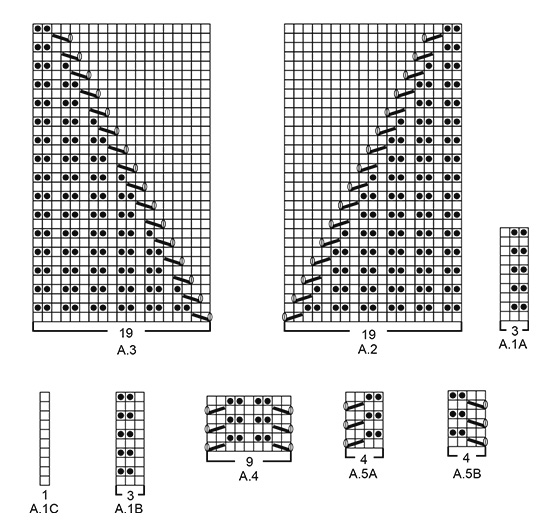
|
||||||||||||||||
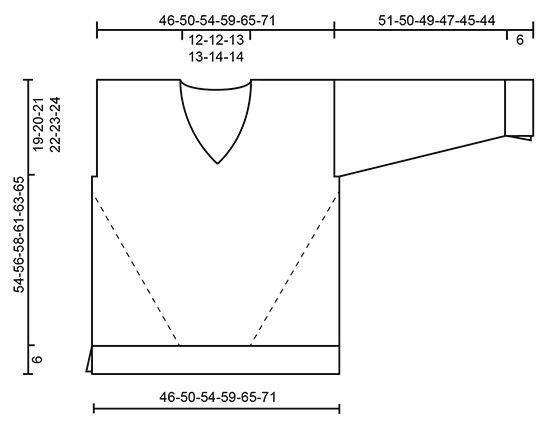
|
||||||||||||||||
|
Have you made this or any other of our designs? Tag your pictures in social media with #dropsdesign so we can see them! Do you need help with this pattern?You'll find tutorial videos, a Comments/Questions area and more by visiting the pattern on garnstudio.com. © 1982-2024 DROPS Design A/S. We reserve all rights. This document, including all its sub-sections, has copyrights. Read more about what you can do with our patterns at the bottom of each pattern on our site. |
||||||||||||||||









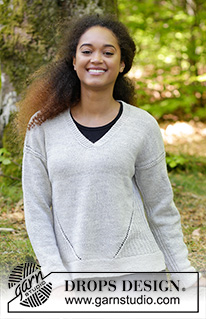
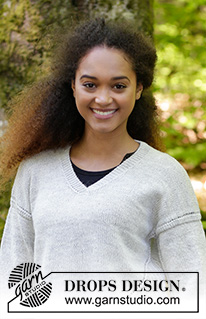


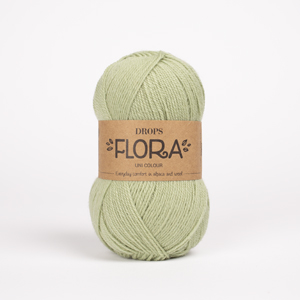
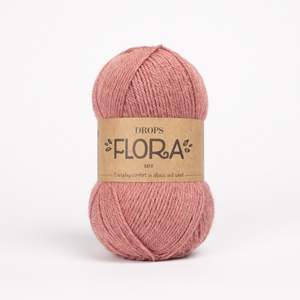






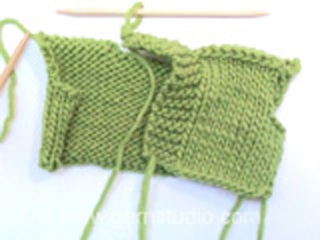








































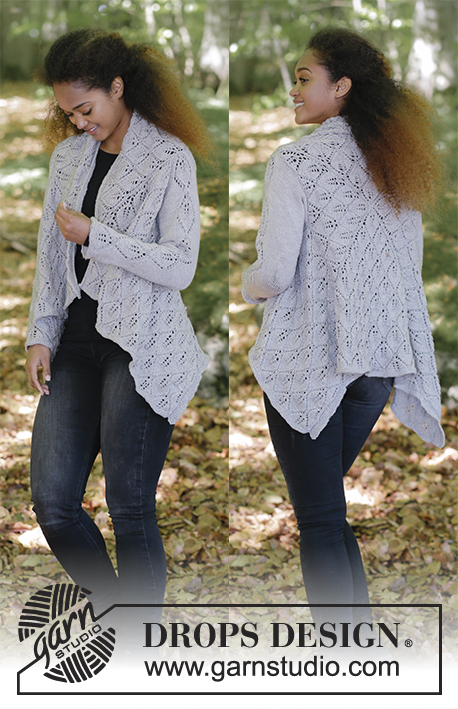






Comments / Questions (22)
Hva menes med 9 masker steukturmønster? Betyr det 9 masker med midtmasken under ermet?
05.01.2023 - 18:29DROPS Design answered:
Hei Ellen. Mønstret du strikker / diagrammer = strukturmønster, og når det gjenstår totalt 9 masker med strukturmønster i hver side på bolen settes det 1 merketråd i den midterste av disse 9 maskene i hver side – la merketrådene følge med videre oppover. Detter er da under ermet ja. mvh DROPS Design
06.01.2023 - 14:03Ich verstehe leider die Diagramme im Rumpfteil nicht. Sind hier nun lediglich jede zweite Runde, also 1, 3, 5 usw. Eingezeichnet oder ist jede Runde eingezeichnet? Mir erschließt sich das nicht und ich finde die Bezeichnung Hin+und Rückreihen sehr irreführend
28.08.2022 - 21:10DROPS Design answered:
Liebe Frau Stammkötter, beide Hin- und Rückreihe sind im Diagram gezeichnet; Hinreihen lesen Sie rechts nach links und Rückreihen lesen Sie links nach rechts. A.1A (als Beispiel) stricken Sie so: 1. Reihe (Hinreihe): 3 M rechts, 2. Reihe (RückReihe): 1 M links, 2 M re. So bekommen Sie ein RippenMuster: 2 M kraus rechts, 1 Masche glatt rechts. Viel Spaß beim stricken!
29.08.2022 - 09:03After you complete the 10 rows of pattern A1A and B do you switch to stockinette for those stitches or do you stay in pattern?
11.06.2020 - 19:33DROPS Design answered:
Dear Mrs Bondy, after you have worked the 10 rows of A.1A and A.1B repeat these rows in height until there are 9 sts remaining in pattern (due to A.2 and A.3) to work A.4. Happy knitting!
12.06.2020 - 07:47I'm having trouble with knowing where to start the 9 stitch pattern under the arm in the pattern A.2 and A.3 as I am not seeing a place where 9 stitches would be left in the "texture"?
14.12.2019 - 01:01DROPS Design answered:
Dear JR, when working A.2 and A.3 on body, the lace/texture pattern will goes diagonally = there will be more stocking stitch in the middle of front/back piece and less stitches worked in texture pattern between the yarn overs (see end of A.2 and beg of A.3 in diagram). When only 9 stitches in texture pattern remain in each side, you then work A.4 over these 9 stitches (= starting and ending with the lace pattern as before + texture as before). Happy knitting!
16.12.2019 - 07:50I am just having some trouble understanding the below section: When 9 stitches in textured pattern remain in each side of body, insert 1 marker thread in the middle of these 9 stitches in each side . Now work A.4 over the middle 9 stitches in each side. And do I continue these 9 stitches until said measurement is reached?
10.12.2019 - 20:22DROPS Design answered:
Dear JR, yes, you continue working A.4 over these 9 stitches on each side undtil piece measures 35-36-37-39-40-41 cm and now cast off the stitch with the marker thread on each side and continue each piece separately. Happy knitting!
11.12.2019 - 08:18Beautiful. I can't wait to start
03.08.2019 - 19:36Bonjour je ne comprend pas se que deviennent les 33 mailles de A1A et les 33 mailles de A1B. Vu que A2 et A3 on toujours 19 mailles chacun ?
26.07.2019 - 12:30DROPS Design answered:
Bonjour Mme Kuntz! Continuer le point fantaisie, les diagrammes A.2 et A.3 vont partir en diagonale sur les côtés comme des triangles, et on aura plus de mailles jersey au milieu devant et au milieu dos. Le nombre totale de mailles est le meme. Bon tricot!
27.07.2019 - 00:02Hoe brei ik een kantsteek?
20.05.2019 - 19:07DROPS Design answered:
Dag Maartje,
Een kantsteek brei je in ribbelsteek, dus zowel de heengaande als de teruggaande naald recht.
22.05.2019 - 13:01MERCI il me semblait bien que A2 et A3 mangeaient les autres diagrammes!!!!! Bravo et merci pour cette prompte bienveillance à répondre,
30.04.2019 - 10:11Merci de votre prompte réponse, mais désolée ne vois pas comment arriver à ces 9 mailles? Où sont elles? Faut il répéter A1A et A1B pour obtenir même hauteur que diagrammes A2 et A3? Merci
29.04.2019 - 17:57DROPS Design answered:
Bonjour Anne B, vous allez continuer A.2 et A.3 pour continuer les diagonales ajourées, le nombre de mailles entre A.2 et A.3 (= A.1, A.1B et A.1C) vont progressivement diminuer, "mangées" par A.2 et A.3, quand il restera 9 mailles en point texturé de chaque côté, tricotez alors A.4 sur ces 9 m. Bon tricot!
30.04.2019 - 09:48